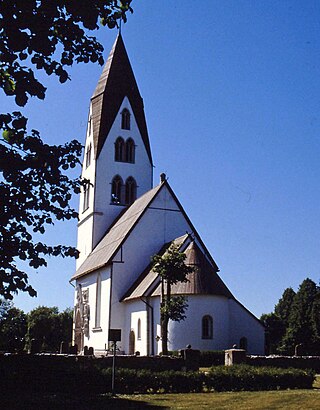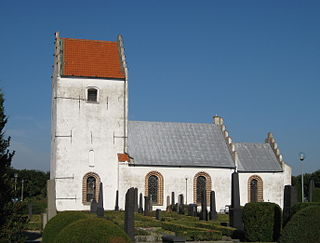
Visby Cathedral, formally Visby Saint Mary's Cathedral, is a cathedral within the Church of Sweden, seat of the Bishop of Visby. It lies in the centre of Visby, the main town on the Swedish island Gotland. It was built as the church of the German traders in the city during the 13th century. The first church was probably a wooden church, which was later replaced by a stone building. Originally built as a basilica, it was successively expanded and rebuilt during the Middle Ages. At the end of this period it had been transformed to a hall church, which it still is. In 1361, Gotland and the church became part of Denmark. Following the Reformation, it was the only medieval church in the city left in use, and in 1572 raised to the status of cathedral. Since 1645 Gotland and the cathedral have been part of Sweden. A major renovation was carried out in 1899–1903 under the guidance of architect Axel Haig.

Bro Church is a medieval era Lutheran church at Bro on the Swedish island Gotland. Situated on what was possibly a pre-Christian sacred site, the presently visible church was built during the 13th century. Stylistically, its architecture shows a mix of Romanesque and Gothic elements. It still contains some medieval furnishings, including a baptismal font by Sigraf, and murals. The church belongs to the Väskinde parish in the Diocese of Visby of the Church of Sweden.

Garde Church is a medieval church in Garde on the Swedish island of Gotland. It was built in stages during the Middle Ages. The oldest part is the nave and the base of the tower, while the most recently constructed part is the large chancel. A large renovation was carried out in the 1960s. Garde Church together with its cemetery and its four lychgates constitute one of the most well-preserved medieval church ensembles in Sweden.

Hejdeby Church is a medieval church in Hejdeby on the Swedish island of Gotland. The church was built in stages during the 13th century, and contains medieval murals from two different periods. Hejdeby Church is part of the Diocese of Visby within the Church of Sweden.

Anga Church is a 13th century church in Anga on the Swedish island of Gotland. It is one of the most well-preserved Romanesque churches on Gotland, and was possibly preceded by a stave church. Inside, the church is decorated with medieval murals from three different periods, as well as some medieval furnishings. Some wooden sculptures from the church are today exhibited in a museum in Visby. The church belongs to the Church of Sweden and lies within the Diocese of Visby.

Stenkyrka Church is a medieval church in Stenkyrka on the Swedish island of Gotland. Although the current church dates from the 13th century, it was probably preceded by one of the earliest churches on Gotland at this site. Stenkyrka Church is dominated by its large tower and its interior is decorated with medieval murals. It belongs to the Church of Sweden and lies in the Diocese of Visby.

Lye Church is a medieval church on Gotland, Sweden. The oldest parts of the church date from the last quarter of the 12th century, and the last major addition was the disproportionately large chancel, built during the second quarter of the 14th century by a workshop known by its notname as Egypticus. The workshop was also responsible for constructing the largest of the church portals, which is also decorated with Gothic stone sculpture. The tower portal contains sculptures attributed to the Romanesque sculptor Sigraf. The church has been little altered since the end of the Middle Ages. Lye Church contains the largest preserved set of medieval stained glass windows in the Nordic countries, and its interior is also decorated by medieval wall paintings, uncovered in the 1950s. The altarpiece is from 1496, and the church also contains a triumphal cross from the same period.

Stånga Church is a medieval church in Stånga on the Swedish island of Gotland. The site of the church has probably been considered sacred since before the Christianization of Scandinavia.

Hemse Church is a medieval Lutheran church in Hemse on the island of Gotland. Preceded by the most well-preserved early stave church discovered in Sweden, the current church dates mainly from the 13th century. It contains sets of medieval murals as well as some medieval furnishings. It is part of the Diocese of Visby.

Eke Church is a medieval church in Eke on the Swedish island of Gotland. The church was built during the 12th and 13th century, with only smaller additions and changes made later. Inside, several medieval murals survive. The church is used by the Church of Sweden and lies in the Diocese of Visby.

Lärbro Church is a medieval church in Lärbro on the Swedish island of Gotland. The church is located at a former strategically important spot, as testified by the adjacent fortified tower. The presently visible Gothic church replaced an earlier Romanesque church during the 13th and 14th century. The cemetery of the church contains several graves of victims from Nazi concentration camps who were taken to a field hospital in Lärbro during and after World War II.

Mästerby Church is a medieval church in Mästerby on the Swedish island of Gotland. It is richly decorated with medieval murals. Mästerby Church belongs to the Diocese of Visby.

Stenkumla Church is a medieval church in Stenkumla on the island of Gotland, Sweden. It belongs to the Diocese of Visby. During the Middle Ages, the church was dedicated to Saint Lawrence.

Vallstena Church is a medieval church on the island of Gotland, Sweden. It belongs to the Diocese of Visby.

Othem Church is a medieval church in Othem on Gotland, Sweden. It was built in the 13th century and contains several medieval murals.

Hamra Church is a medieval church in Hamra, Gotland, Sweden.

Östergarn Church is a medieval church in Östergarn, Gotland, Sweden.

The Viklau Madonna is a late 12th-century wooden Madonna, probably made on Gotland in present-day Sweden. The statuette is one of the best-preserved 12th-century wooden statuettes from Europe. Named after the medieval Viklau Church where it was originally located, it was bought by the Swedish History Museum in 1928 and is today in the museum in Stockholm. In 2017, it was discovered that a relic had been placed inside the statuette. The statuette depicts Mary, wearing gilded clothes and a golden crown, sitting on a tall chair. Originally, the Madonna was depicted holding the infant Christ in her arms, but this part of the sculpture has been lost.

Bjällerup Church is a medieval church in Stora Bjällerup, a village in Staffanstorp Municipality, Scania, Sweden. It belongs to the Church of Sweden. It is one of the oldest churches in the province, and contains medieval furnishings and murals from the 14th century.





















